Hey guys! My grandma and I just made this amazing ahi tuna recipe for dinner, and I had to share it with you. It's quick, easy, and perfect for busy weeknights when you want something that feels fancy without the fuss. Plus, my grandma shared her secret trick to make this ahi tuna recipe extra flavorful—let me show you how it's done!
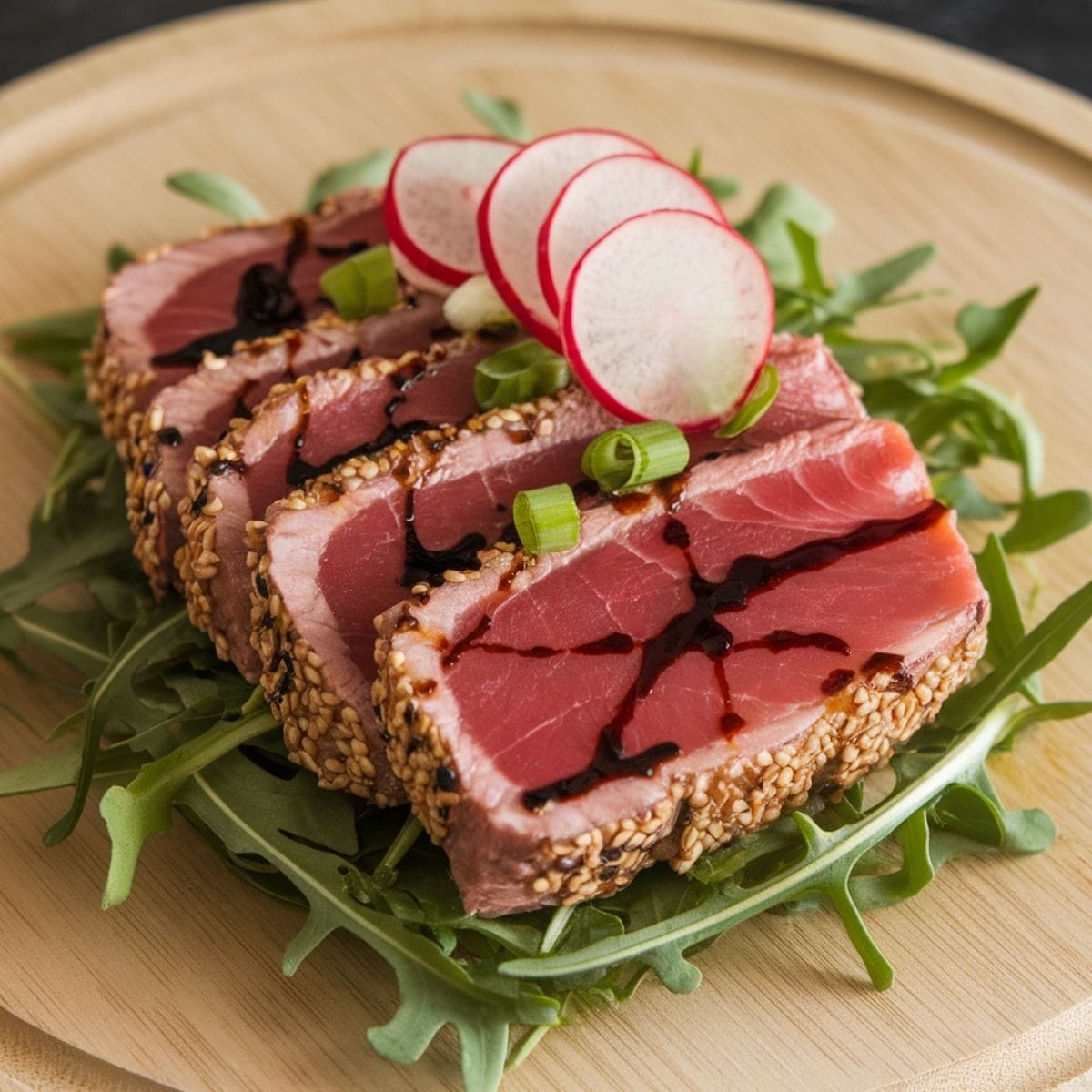
There's something special about this ahi tuna recipe that always feels like a restaurant-quality meal, but the truth is, it's one of the easiest proteins to prepare at home. The key to a perfect ahi tuna recipe is starting with great quality fish and knowing a few simple techniques to get that perfect sear while keeping the center beautifully rare. Grandma taught me that respecting the ingredients and keeping things simple often leads to the most delicious ahi tuna recipe results.
Jump to:
Ingredients
Here's what you'll need to make this recipe. Check out the image below to see all the ingredients prepped and ready to go!
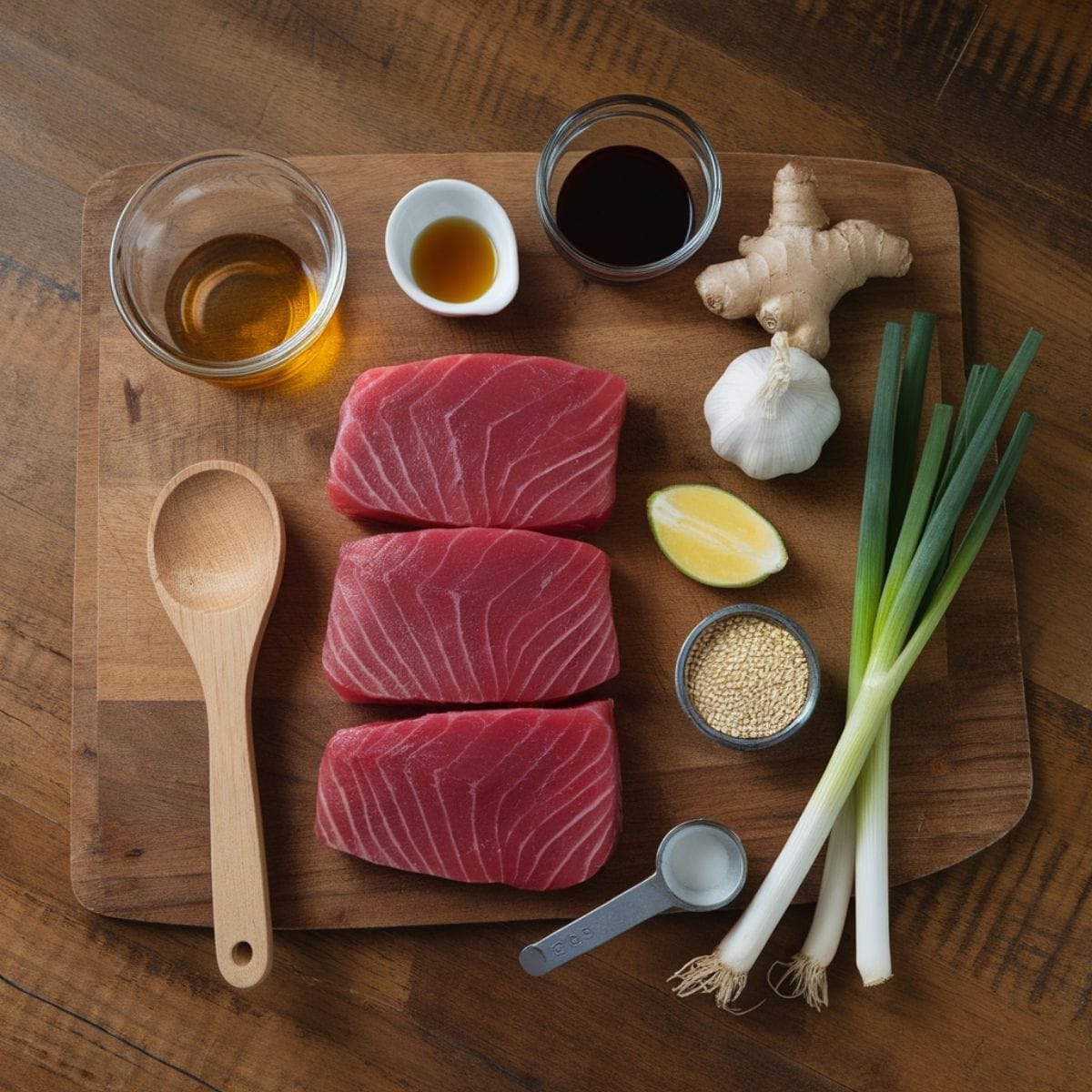
- 2 ahi tuna steaks (about 6 oz each), sushi-grade
- 2 tablespoons sesame oil
- 2 tablespoons soy sauce
- 1 tablespoon rice vinegar
- 1 teaspoon honey
- 1 teaspoon fresh ginger, grated
- 2 cloves garlic, minced
- 2 tablespoons sesame seeds (mix of black and white if available)
- 1 teaspoon freshly ground black pepper
- ¼ teaspoon salt
- 2 green onions, thinly sliced for garnish
- Optional: 1 teaspoon wasabi paste
- Optional: 1 tablespoon sriracha for a spicy variation
I've chosen these ingredients because they create the perfect balance of umami, sweetness, and acidity that complements the natural richness of the ahi tuna recipe. Grandma always says that good quality tuna doesn't need much to shine in an ahi tuna recipe, but these few ingredients enhance its natural flavors without overpowering them. The sesame seeds not only add a beautiful crust to your ahi tuna recipe but also bring a lovely nuttiness to each bite.
Instructions
Follow these steps to make the perfect ahi tuna recipe. Don't forget to check out the step-by-step images to guide you through this ahi tuna recipe!
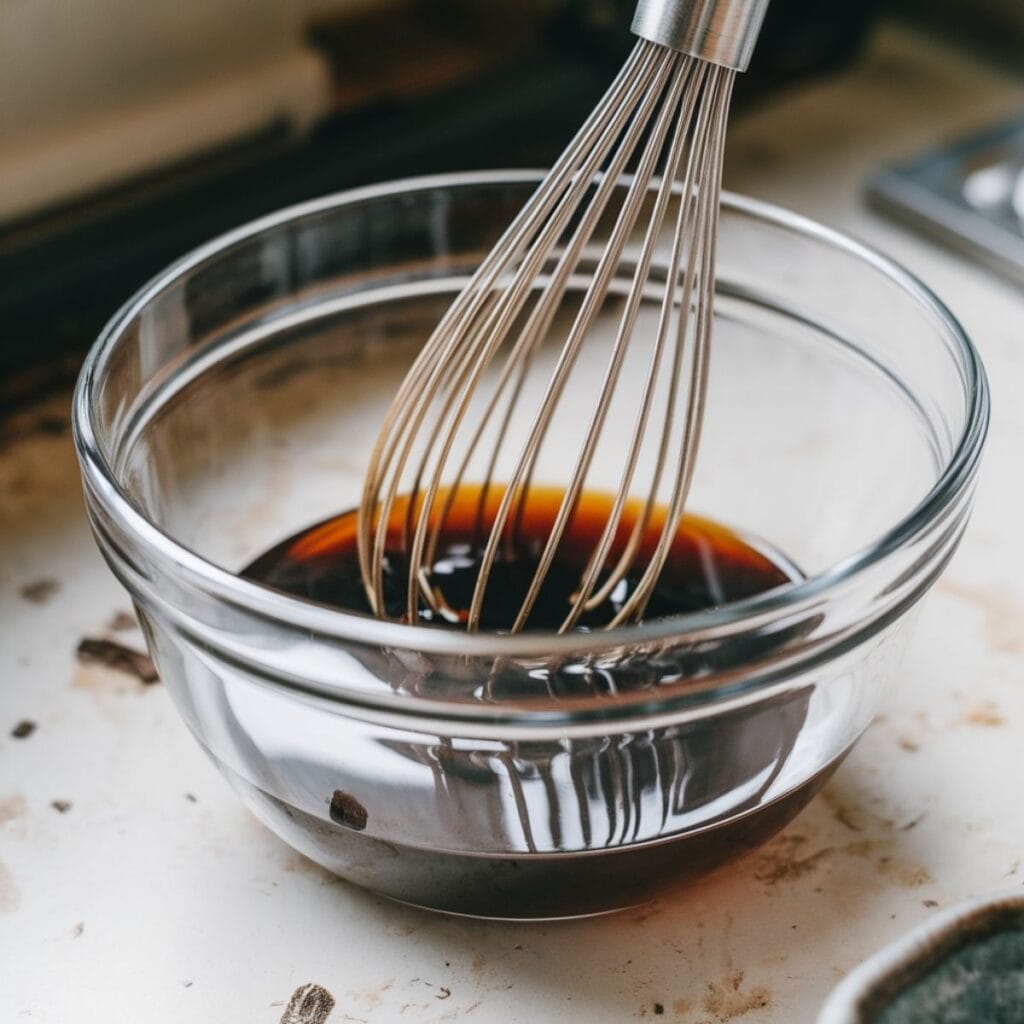
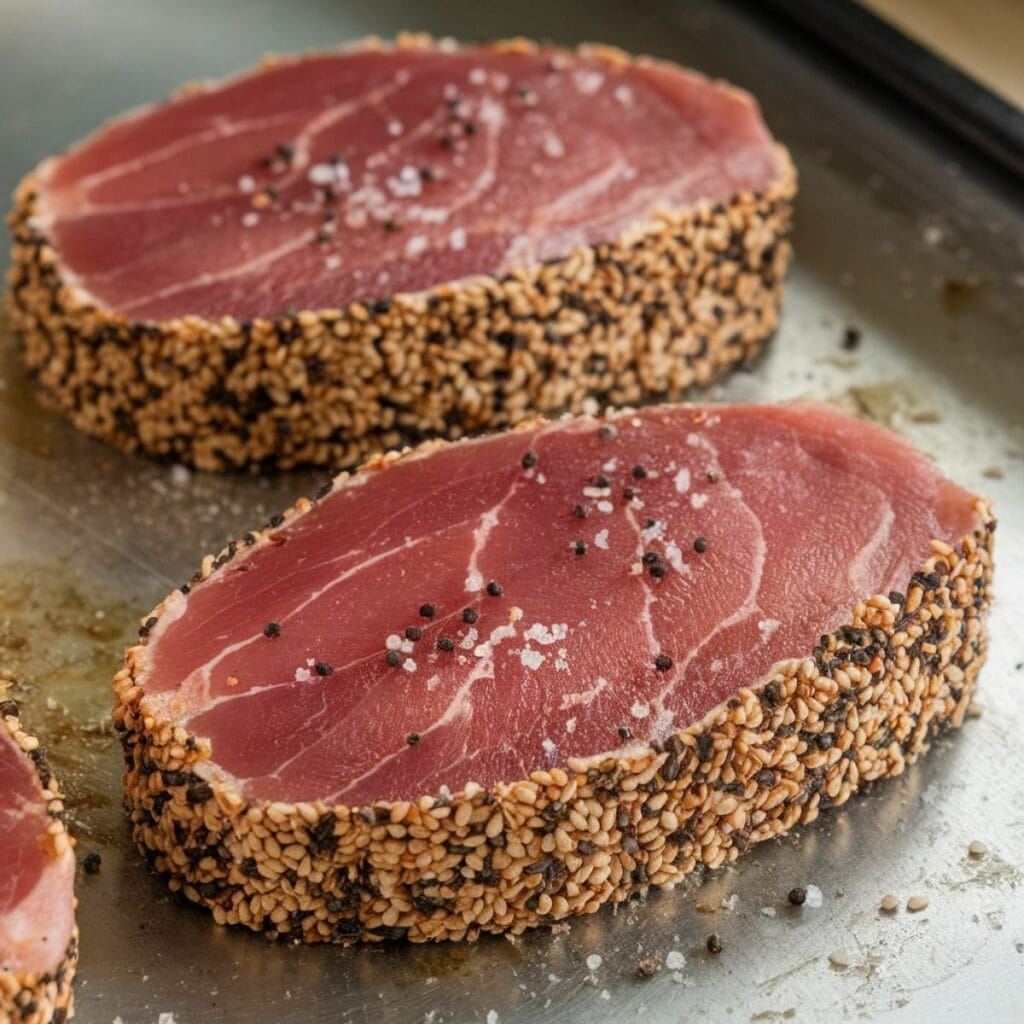
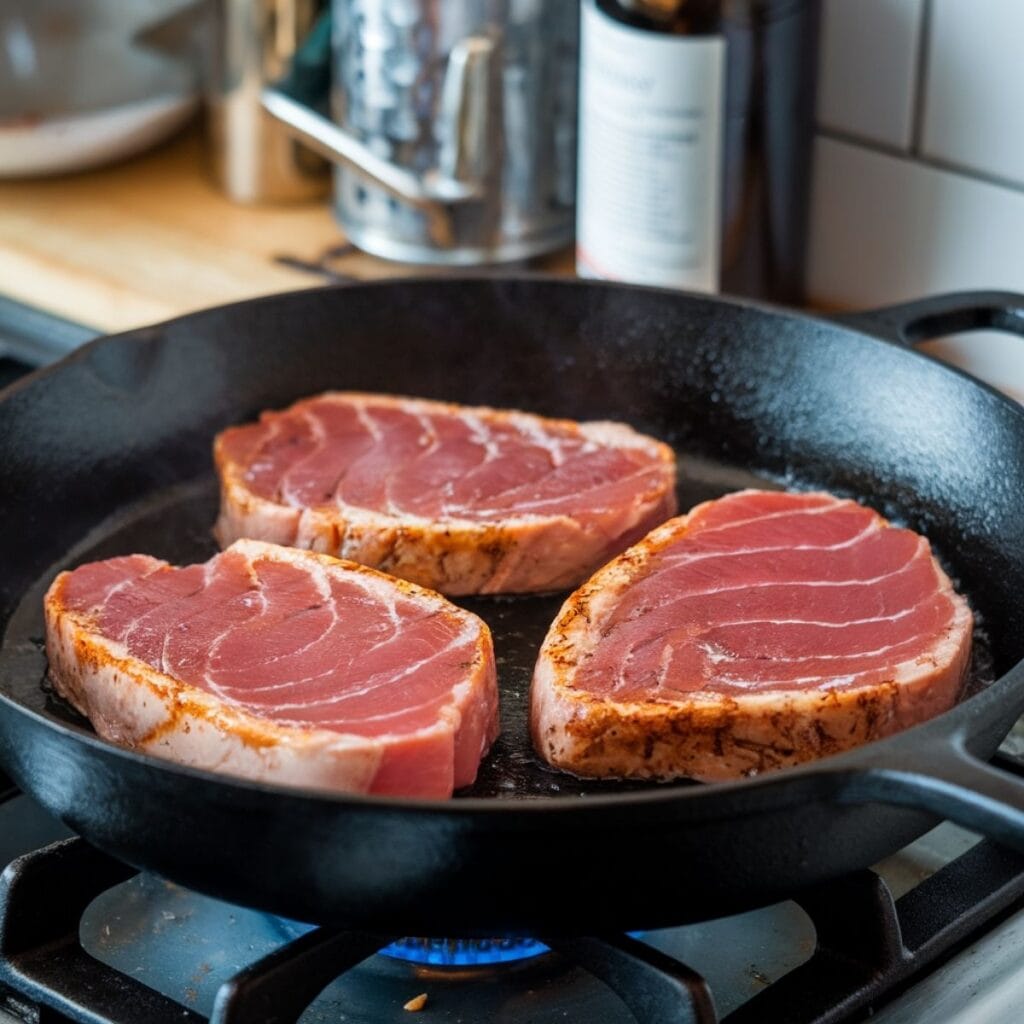
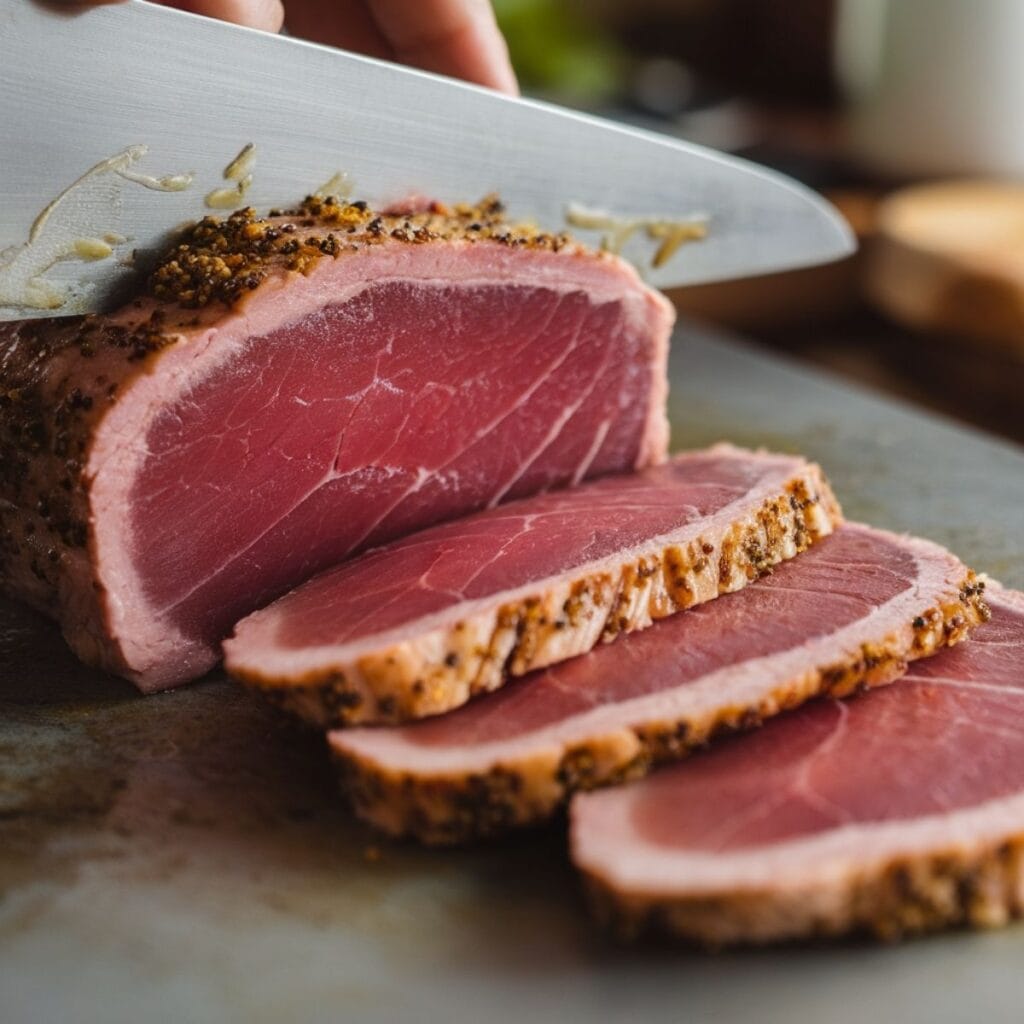
Step 1: Prepare the marinade: In a shallow dish, whisk together the sesame oil, soy sauce, rice vinegar, honey, grated ginger, and minced garlic until well combined. This marinade is my grandma's special blend that adds just the right amount of flavor without overwhelming the delicate taste of the tuna.
Step 2: Prep the tuna steaks: Pat the tuna steaks dry with paper towels. This is crucial for getting that perfect sear later! Grandma always says, "Dry fish means a beautiful crust."
Step 3: Quick marinade: Place the tuna steaks in the marinade and flip them to coat both sides. Let them sit for just 5-10 minutes. Grandma taught me that ahi tuna should never be marinated for too long as the acidity can start to "cook" the fish and change its texture.
Step 4: Prepare the crust: On a plate, mix the sesame seeds, black pepper, and salt. Remove the tuna from the marinade and press each side into the sesame seed mixture, creating an even crust.
Step 5: Heat the pan: Place a heavy-bottomed skillet (cast iron works best) over high heat until it's very hot. Grandma's test: sprinkle a few drops of water on the pan – if they sizzle and evaporate immediately, it's ready!
Step 6: Sear to perfection: Add a thin layer of oil to the hot pan, then carefully place the tuna steaks in the skillet. Sear for exactly 45 seconds to 1 minute on each side for rare, or 1-2 minutes per side for medium-rare. The sesame seeds should turn golden brown and form a beautiful crust.
Step 7: Rest the tuna: Transfer the seared tuna to a cutting board and let it rest for 1-2 minutes. This helps the juices redistribute throughout the fish, ensuring every bite is moist and flavorful.
Step 8: Slice and serve: Using a sharp knife, slice the tuna against the grain into ½-inch thick pieces. Arrange on a plate, garnish with sliced green onions, and serve immediately with any remaining marinade drizzled on top or as a dipping sauce.
Grandma always watches me like a hawk during steps 5 and 6, reminding me that the secret to a perfect ahi tuna recipe is a scorching hot pan and not walking away even for a second. "This isn't the time to check your phone," she jokes as we watch the ahi tuna recipe come together to perfection.
Cooking Tips
Don't stress about getting the perfect doneness on your first try with this ahi tuna recipe! My first attempt at this ahi tuna recipe was a disaster (I was too scared of undercooking it and ended up with something that resembled tuna jerky). Here are some practical tips to make your ahi tuna recipe experience easier:
- For this ahi tuna recipe, your tuna steaks should be at least 1-inch thick for the best results. Thinner steaks will cook through too quickly in this ahi tuna recipe.
- Use a timer! When you're preparing this ahi tuna recipe and searing for just 45-60 seconds, even 15 extra seconds can make a difference.
- Trust the process: a properly executed ahi tuna recipe should result in tuna that's rare in the center. If you're nervous about eating rare fish, remember that sushi-grade ahi is safe to eat raw.
- Don't move the tuna around in the pan when making this ahi tuna recipe – place it down and let it sear undisturbed for the best crust.
- If you're cooking this ahi tuna recipe for people who prefer their tuna more done, you can always sear the edges of the steaks as well by holding them with tongs for 30 seconds on each edge.
My Ahi Tuna Journey: From Disaster to Delicious
The first time I tried making this ahi tuna recipe on my own without Grandma's supervision, I invited friends over for what I promised would be an "impressive dinner." I was so nervous about timing this ahi tuna recipe that I completely forgot to pat the tuna dry before searing. The result? A sad, steamed-looking ahi tuna recipe with no beautiful sear in sight. When I called Grandma in a panic about my failed ahi tuna recipe, she laughed and said, "Jassmine, you know what to do better next time. Cooking is just learning from your mistakes!"
Now, this ahi tuna recipe has become my go-to when I want to impress without spending hours in the kitchen. Even my brother, who claims he doesn't like fish, asks for this ahi tuna recipe whenever he visits. Grandma beams with pride every time I make this ahi tuna recipe, saying the student has become the master (though I know I still have many years of learning ahead of me).
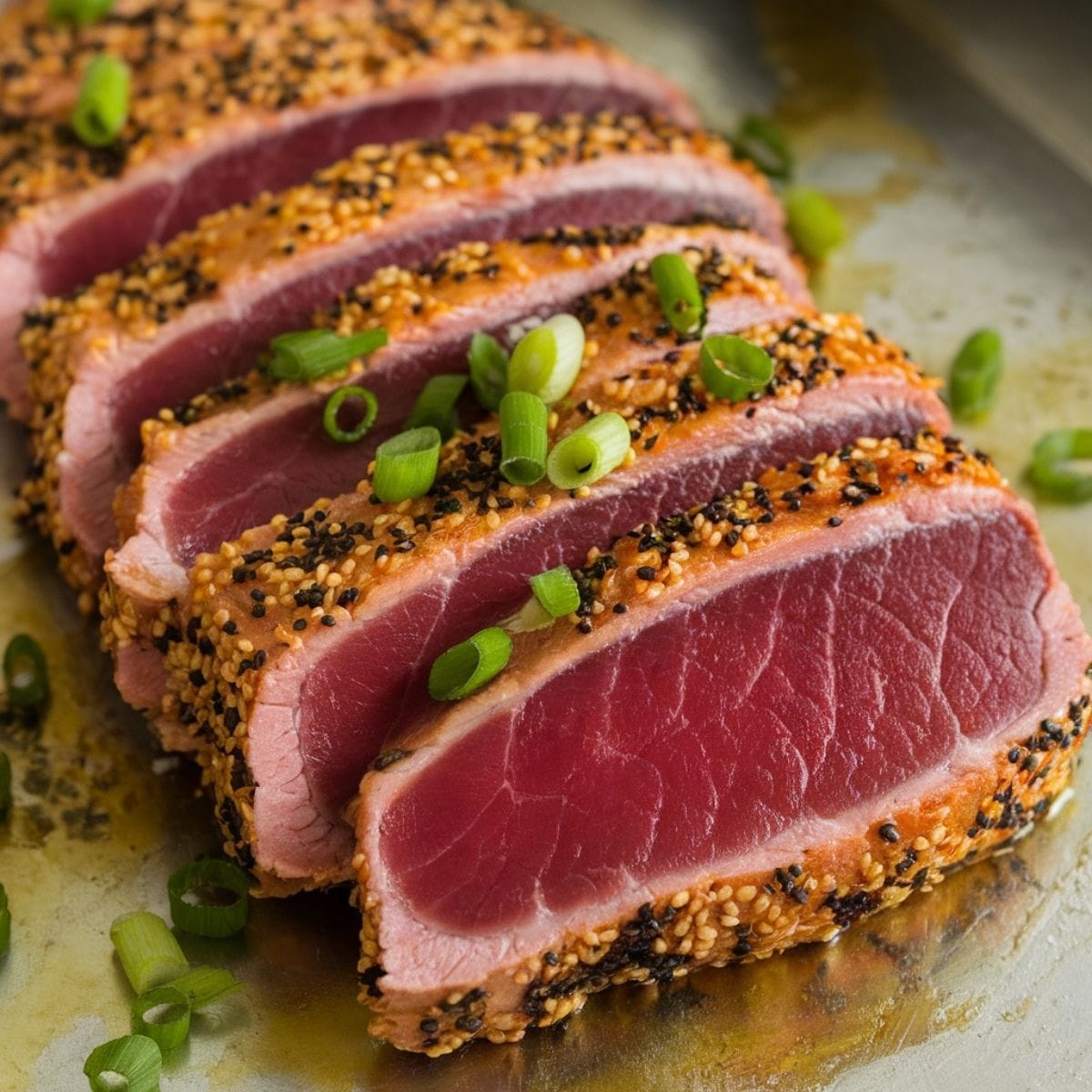
Substitutions
If you need to adjust this recipe for dietary preferences, here are some easy swaps:
- Gluten-free: Replace regular soy sauce with tamari or coconut aminos.
- Lower sodium: Use low-sodium soy sauce and reduce the added salt in the crust.
- Honey alternatives: Maple syrup or agave nectar work well as substitutes for honey.
- Sesame allergies: Skip the sesame oil and seeds and opt for a cracked pepper crust instead. You can use olive oil in the marinade.
Grandma always reminds me that recipes are guides, not rules. "Make it work for you," she says, "that's how family recipes evolve over time."
Variations
Want to mix things up? Try these fun variations:
Spicy Tuna Poke Bowl
Transform this recipe into a delicious poke bowl by dicing the ahi tuna instead of searing it. Marinate the cubed ahi tuna in the same mixture, add some sriracha for heat, and serve over rice with avocado, cucumber, and seaweed salad. Grandma and I make this version during summer when we want something refreshing.
Smoked Ahi Tuna
For a flavor similar to Trader Joe's smoked ahi tuna, you can use a cold smoking technique if you have a smoker. Marinate the tuna as directed, then cold smoke for 1-2 hours before searing for an incredible depth of flavor. Grandma discovered this method when a neighbor shared their smoking equipment, and now it's a special treat whenever we can make it.
Tanioka's-Inspired Spicy Ahi
After visiting Hawaii, Grandma was obsessed with recreating Tanioka's spicy ahi. For this variation, finely dice the ahi tuna and mix with mayo, sriracha, soy sauce, a touch of sesame oil, and green onions. Serve on crackers or with wonton chips for an appetizer that disappears in minutes at family gatherings.
Citrus-Herb Crusted Ahi
Instead of the Asian-inspired flavors, try a Mediterranean twist with a crust of lemon zest, fresh herbs (dill, parsley, and thyme work well), and cracked pepper. Serve with a side of lemon-caper sauce for a bright, fresh flavor profile.
Equipment
Here's what we use to make this recipe:
- A heavy-bottomed skillet or cast-iron pan: This ensures even heating and the best sear. Grandma's cast iron pan is over 50 years old and still performs perfectly!
- Sharp chef's knife: Essential for cleanly slicing the tuna after searing.
- Shallow dish for marinating: Nothing fancy needed here.
- Tongs: For safely flipping the tuna steaks.
- Timer: Crucial for getting the perfect doneness.
If you don't have a cast-iron skillet, any heavy-bottomed pan will work, but you might need to adjust the heat slightly. The key is getting the pan very hot before adding the tuna. As Grandma says, "You should hear that satisfying sizzle when the fish hits the pan!"
Storage
While seared ahi tuna is best enjoyed immediately after cooking, sometimes you might have leftovers. Here's how to store them properly:
- Refrigerate any leftover tuna in an airtight container for up to 2 days.
- I don't recommend freezing seared ahi tuna as it can significantly change the texture.
- If you have leftover tuna, try flaking it and making a tuna salad with some mayo, celery, and a squeeze of lemon for a delicious next-day lunch.
- The unused marinade (that hasn't touched the raw fish) can be stored in the refrigerator for up to a week and used as a dressing for salads or a marinade for other proteins.
Grandma insists that the best way to store this dish is "in your belly, not your fridge," and I have to agree that it rarely lasts long enough for storage to be a concern!
Top Tip
My grandma's secret tip for perfect ahi tuna is to make sure your tuna steaks are at room temperature before searing. Take them out of the refrigerator 15-20 minutes before you plan to cook them. This ensures even cooking and the best texture. "Cold fish in a hot pan will seize up," Grandma always warns. "Give it time to relax before the heat hits it."
Another game-changing tip she taught me was to put the sesame seeds in a dry pan and lightly toast them before using them for the crust. This extra two-minute step elevates the nutty flavor and makes the crust even more delicious. Just be sure to watch them closely as they can burn quickly!
FAQ
How is ahi tuna best cooked?
Ahi tuna is best cooked with a quick sear on the outside while keeping the center rare to medium-rare. The high heat creates a flavorful crust while preserving the tender, melt-in-your-mouth texture inside. Overcooking ahi tuna will make it dry and tough, similar to canned tuna. For food safety, always use sushi-grade ahi tuna if you're planning to serve it rare in the center.
Should I marinate ahi tuna before searing?
A brief marinade (5-10 minutes) adds flavor without "cooking" the fish in the acidic ingredients. Longer marinades can actually start to break down the protein and affect the texture negatively. If you want more flavor, consider using a dry rub or serving with a flavorful sauce instead of marinating for too long. My grandma says, "Respect the fish—sometimes less is more."
How does Gordon Ramsay cook ahi tuna?
Gordon Ramsay typically sears his ahi tuna quickly over very high heat (1-2 minutes per side) and often uses a sesame seed crust similar to our recipe. He emphasizes the importance of a smoking hot pan, patting the fish completely dry before searing, and allowing the tuna to rest before slicing. His technique focuses on simplicity to let the quality of the fish shine through.
What seasonings are good on tuna?
Tuna pairs beautifully with:
Asian flavors: Soy sauce, ginger, garlic, sesame, wasabi, and citrus
Mediterranean flavors: Lemon, capers, olive oil, fresh herbs (parsley, dill, oregano)
Heat elements: Black pepper, chili flakes, sriracha, or cajun seasoning
Salt variants: Sea salt, soy sauce, or tamari all enhance tuna's natural flavors
Grandma's philosophy is that seasonings should complement the fish, not overpower it. "You paid good money for that beautiful tuna," she reminds me. "Don't hide it under too many spices."
Conclusion
Making this ahi tuna recipe with my grandma reminded me why I love cooking so much—it's not just about the food, but the memories we create along the way. What seems like a simple ahi tuna recipe becomes something special when you understand the little details that make it perfect: the sizzle of tuna hitting a hot pan in this ahi tuna recipe, the nutty aroma of toasted sesame seeds, and the beautiful pink center when you slice into this ahi tuna recipe.
The best part about this ahi tuna recipe is that it feels fancy enough for special occasions but is quick enough for weeknight dinners. In just 30 minutes, you can transform a few simple ingredients into an ahi tuna recipe that looks and tastes like it came from a high-end restaurant.
I hope this ahi tuna recipe becomes a favorite in your home too! The techniques you'll learn making this ahi tuna recipe will translate to many other quick, elegant meals. If you loved this ahi tuna recipe, check out my other family favorites: Garlic Butter Steak Bites for another quick protein option or The Best German Chocolate Cake Recipe for a delicious dessert to follow this meal. Both make perfect accompaniments to this ahi tuna recipe!
And please let me know in the comments if you try this ahi tuna recipe or any of the variations. Grandma and I love hearing how our ahi tuna recipe turns out in your kitchens. Happy cooking with this ahi tuna recipe!
Related
Looking for other recipes like this? Try these:
Pairing
These are my favorite dishes to serve with [this recipe]:
recipe

ahi tuna recipe -seared
Equipment
- 1 Heavy-bottomed skillet or cast-iron pan A cast-iron skillet works best for achieving a perfect sear.
- 1 Sharp chef's knife Essential for slicing the tuna cleanly.
- 1 Shallow dish For marinating the tuna.
- 1 Tongs For flipping the tuna steaks safely.
Ingredients
- 2 steaks Ahi tuna (sushi-grade, about 6 oz each) Ensure it’s sushi-grade for safety
- 2 tablespoons Sesame oil Adds a nutty flavor to the marinade
- 2 tablespoons Soy sauce Use low-sodium if preferred.
- 1 tablespoon Rice vinegar Adds a touch of acidity
- 1 teaspoon Honey Balances the flavors with a hint of sweetness
- 1 teaspoon Fresh ginger (grated) Adds a zesty, aromatic flavor
- 2 cloves Garlic (minced) Enhances the umami profile
- 2 tablespoons Sesame seeds (black and white mix) Toasted for extra nuttiness
- 1 teaspoon Freshly ground black pepper Adds a subtle kick
- ¼ teaspoon Salt Enhances the natural flavors
- 2 stalks Green onions (thinly sliced) For garnish
Instructions
- In a shallow dish, whisk together sesame oil, soy sauce, rice vinegar, honey, grated ginger, and minced garlic until well combined
- Pat the tuna steaks dry with paper towels to ensure a perfect sear
- Place the tuna steaks in the marinade, flipping to coat both sides. Let sit for 5-10 minutes
- On a plate, mix sesame seeds, black pepper, and salt. Remove the tuna from the marinade and press each side into the sesame seed mixture to create an even crust
- Place a heavy-bottomed skillet over high heat until very hot. Test by sprinkling a few drops of water—if they sizzle and evaporate immediately, it’s ready
- Add a thin layer of oil to the hot pan. Carefully place the tuna steaks in the skillet. Sear for 45 seconds to 1 minute on each side for rare, or 1-2 minutes per side for medium-rare
- Transfer the seared tuna to a cutting board and let it rest for 1-2 minutes to allow the juices to redistribute
- Using a sharp knife, slice the tuna against the grain into ½-inch thick pieces. Garnish with sliced green onions and serve immediately
Notes
- For a gluten-free version: Replace soy sauce with tamari or coconut aminos.
- For a spicy kick: Add 1 tablespoon of sriracha to the marinade.
- Storage: Best enjoyed immediately, but leftovers can be refrigerated for up to 2 days.
- Serving suggestion: Serve with a side of steamed rice or a fresh salad for a complete meal.





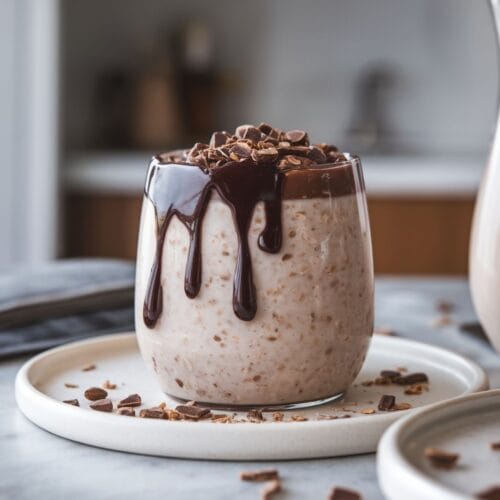


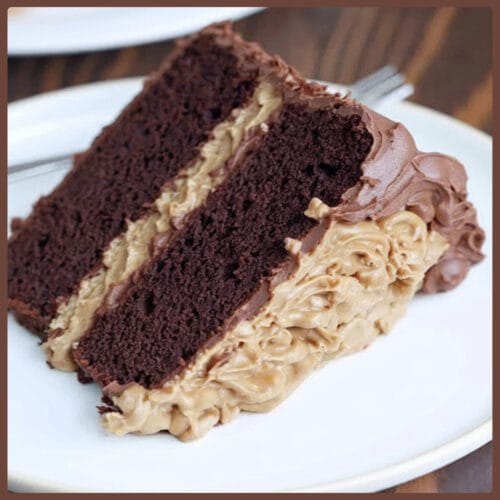

Leave a Reply